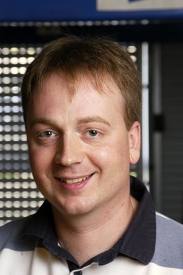Invited Talk by Prof. Dr. Alexandre Krupa: Contributions to ultrasound visual servoing
 |
IRISA INRIA Rennes, France
|
Contributions to ultrasound visual servoing
Abstract:The objective of our research work is to control in a visual closed-loop manner the full motion of a 2D (US) ultrasound probe actuated by a medical robot in order to reach and track a desired cross-section image. Considering the ultrasound modality in visual servoing is not an easy task since an US probe differs strongly from a camera. In fact, an US probe provides only information in its observation plane whereas a camera gives a 2D projection of the complete 3D world. Moreover, US images exhibit very low SNR that increases the difficulty to extract in real-time robust visual information. The aim of our research activity is therefore to propose generic solutions for ultrasound visual seroing. We focus more particularly on the modeling of visual features that can be robustly extracted from US image and that are pertinent to visually control the full motion of a robotized probe. In my talk I will present two categories of approaches we developed. The first considers geometrical features as input of the control scheme that are computed from image moments extracted after a segmentation step of the peroperative US image. This approach has been used to automatically position the probe on a desired organ cross-section or to perform registration of 3D preoperative data on 2D US peroperative images. The second approach uses directly ultrasound dense information as input of the robot controller. It eliminates the image segmentation step and allows the consideration of weakly structured images where organ contours are hard to detect. This approach has been applied to automatically compensate physiological motion in order to stabilize the observed peroperative US image.
Bio:
Alexandre Krupa received the M.S. and Ph.D. degrees in control systems and signal processing from the National Polytechnic Institute of Lorraine, Nancy, France, in 1999 and 2003, respectively. He received the "Habilitation à Diriger des Recherches" in Signal processing from the University of Rennes, France, in 2012. His Ph.D. research work was carried out with the eAVR team (Control Vision and Robotics) with the Laboratoire des Sciences de l'Image de l'Informatique et de la Télédétection, Strasbourg, France. From 2002 to 2004, he was an Assistant Associate Professor for undergraduate student lectures in electronics, control, and computer programming with Strasbourg University, Strasbourg, France. Since 2004, he has been a Research Scientist with Inria Rennes, France, where he is currently a member of the Lagadic group. In 2006, he was a Postdoctoral Associate with the Computer Integrated Surgical Systems and Technology Engineering Research Center, Johns Hopkins University, Baltimore, MD. His current research interests include medical robotics, computer-assisted systems in the medical and surgical fields, and, most specifically, the control of medical robots by visual servoing using ultrasound images.
| WebEventForm | |
|---|---|
| Title: | Invited Talk by Prof. Dr. Alexandre Krupa: Contributions to ultrasound visual servoing |
| Date: | 3 May 2013 |
| Location: | Room 03.13.010, FMI-Building |
| Abstract: | The objective of our research work is to control in a visual closed-loop manner the full motion of a 2D (US) ultrasound probe actuated by a medical robot in order to reach and track a desired cross-section image. Read more |
| Imageurl: |  |
| Type: | News |
| Videourl: | |
| Conferencelink: | |
